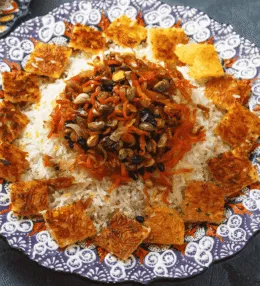
- View
Table of Contents
ToggleSel Roti is more than just a ring shaped treat; it is a symbol of festivity and home in Nepali culture. This traditional rice based doughnut is deep fried until golden and crisp, often prepared during major Hindu festivals like Dashain and Tihar. Its unique texture, mild sweetness and nostalgic aroma make it a staple of family kitchens during celebrations.
While it may look like a doughnut at first glance, Sel Roti has a character all its own. It bridges the gap between a bread and a sweet, offering a crispy outer shell and a soft, slightly chewy centre. Every family has its own way of preparing it, yet the essence remains rooted in heritage and warmth.
Want to dive deeper into Nepalese Cuisine? Don’t miss our post on 15 Traditional Nepalese Foods to Try
What Is Sel Roti?
Sel Roti is a handmade, deep fried ring of fermented rice flour batter, usually sweetened and flavoured with subtle spices. Shaped by hand and poured directly into hot oil, each ring forms its own imperfect circle, which adds to the charm and authenticity of the dish.
Commonly enjoyed at breakfast or as a snack, Sel Roti is best served warm, often accompanied by a cup of milky tea or a savoury side such as curried vegetables or yoghurt. Its versatility makes it welcome on both ceremonial tables and everyday plates.
Ingredients and Taste
The heart of Sel Roti lies in soaked rice, which is ground into a smooth batter. Sugar lends sweetness, while mashed ripe bananas or milk may be added for depth. A touch of ghee, cardamom or clove can offer fragrant notes without overpowering the main ingredient.
The batter is left to ferment slightly, allowing the natural sugars to develop flavour and airiness. Once deep fried, the roti forms a crisp exterior while staying tender and spongy inside. The result is a satisfying contrast of textures, gently sweet but not overly rich.
Sel Roti is not as sugary as many Western desserts. Its appeal comes from its balance, mildly sweet, lightly spiced and comforting. When made with care, each bite carries a whisper of the past, a flavour passed down through generations.
A Taste of History
Sel Roti’s exact origins are difficult to pin down, but its presence in Nepali kitchens stretches back centuries. It has always been closely tied to the rhythms of rural life, where rice is a staple grain and cooking traditions are handed down orally.
It is especially associated with Hindu festivals, where making Sel Roti is often a family affair. Mothers and daughters prepare the batter together, while others fry and cool the rings, sharing stories as they work. In many homes, it is also offered to deities before being shared with loved ones.
Though rooted in village life, Sel Roti has travelled. It is now found across Nepal, from roadside tea stalls to urban sweet shops, and even among Nepali communities abroad. Yet wherever it is made, it carries a sense of ceremony and home.
Sel Roti is more than a festive food. It is a thread of cultural memory, a quiet celebration of family, harvest and heritage. To taste it is to take part in something deeply personal yet proudly shared, a simple delicacy that speaks of Nepal with every bite.
How to Make Sel Roti (Nepali Rice Doughnut)
Sel Roti is a traditional Nepali delicacy, a crispy rice doughnut with a soft, chewy centre. Typically prepared during festivals like Dashain and Tihar, it is both ceremonial and comforting. The process involves soaking and grinding rice into a smooth batter before deep-frying into golden rings. See the recipe card at the bottom for printable directions
Ingredients
- 300 g uncooked rice (preferably short grain)
- 100 g sugar
- 60 ml milk
- 1 medium ripe banana (mashed)
- ½ tsp ground cardamom
- 2 tbsp ghee or unsalted butter (melted)
- 2 tbsp plain flour (optional, for binding)
- A pinch of salt
- Oil or ghee, for deep-frying
Cooking Instructions
Step 1: Soak the rice
Rinse the rice thoroughly until the water runs clear. Soak it in cold water for at least 5 to 6 hours, or overnight for a smoother batter. This ensures the grains soften properly for grinding.
Step 2: Prepare the batter base
Drain the soaked rice and transfer it to a blender. Add milk gradually and blend until you achieve a thick, smooth paste. Avoid adding too much liquid at once to maintain the batter’s consistency.
Step 3: Add sweetness and flavour
Pour the rice paste into a large bowl. Stir in sugar, mashed banana, ground cardamom, melted ghee, and a pinch of salt. Mix until the sugar dissolves completely and the batter is lump-free.
Step 4: Adjust texture
If the batter feels too thin, add a tablespoon or two of plain flour to bind it better. The ideal texture should be slightly pourable but thick enough to hold its ring shape when fried.
Step 5: Rest the batter
Cover the bowl and let the mixture rest for at least 30 minutes. This helps the flavours develop and allows the rice starch to settle, improving texture during frying.
Step 6: Heat the oil
Pour enough oil or ghee into a deep, wide pan to allow the Sel Roti to float freely. Heat on medium until a small drop of batter sizzles and rises instantly to the surface.
Step 7: Shape the Sel Roti
Fill a piping bag, bottle with a small nozzle, or use your hands (traditional method) to form rings directly into the hot oil. Squeeze or pour the batter in a circular motion to create neat doughnut shapes.
Step 8: Fry to golden perfection
Fry one or two rings at a time, turning gently with a stick or tongs. Cook until golden brown on both sides, ensuring the oil is not too hot to avoid uneven cooking.
Step 9: Drain and cool
Remove the Sel Roti and place them on paper towels to absorb excess oil. Allow them to cool slightly so they crisp up further as they rest.
Step 10: Serve and enjoy
Serve warm or at room temperature with spiced potato curry, yoghurt, or milk tea. Their subtle sweetness pairs beautifully with savoury dishes or morning beverages.
Variations and Substitutions
- Rice: Short-grain rice gives the best texture, but jasmine or basmati can be used if soaked longer.
- Banana substitute: Replace with 2 tbsp yoghurt for a mild flavour variation.
- Flavouring: Add a hint of nutmeg or fennel for regional twists found in rural Nepal.
- Vegan version: Use plant-based milk and oil instead of ghee.
Cooking Tips for Perfect Sel Roti
- Keep oil at medium heat for even frying and golden colour.
- Use well-soaked rice for a smooth, lump-free batter.
- Allow the batter to rest to improve elasticity and flavour.
- Practise shaping the rings using a ladle or piping bag before frying.
- Store leftovers in an airtight container and reheat gently before serving.

Sel Roti (Nepali Rice Doughnut)
Ingredients
- 300 g uncooked rice preferably short grain
- 100 g sugar
- 60 ml milk
- 1 medium ripe banana mashed
- ½ tsp ground cardamom
- 2 tbsp ghee or unsalted butter melted
- 2 tbsp plain flour optional, for binding
- A pinch of salt
- Oil or ghee for deep-frying
Instructions
- Rinse the rice thoroughly until the water runs clear. Soak it in cold water for at least 5 to 6 hours, or overnight for a smoother batter. This ensures the grains soften properly for grinding.
- Drain the soaked rice and transfer it to a blender. Add milk gradually and blend until you achieve a thick, smooth paste. Avoid adding too much liquid at once to maintain the batter’s consistency.
- Pour the rice paste into a large bowl. Stir in sugar, mashed banana, ground cardamom, melted ghee, and a pinch of salt. Mix until the sugar dissolves completely and the batter is lump-free.
- If the batter feels too thin, add a tablespoon or two of plain flour to bind it better. The ideal texture should be slightly pourable but thick enough to hold its ring shape when fried.
- Cover the bowl and let the mixture rest for at least 30 minutes. This helps the flavours develop and allows the rice starch to settle, improving texture during frying.
- Pour enough oil or ghee into a deep, wide pan to allow the Sel Roti to float freely. Heat on medium until a small drop of batter sizzles and rises instantly to the surface.
- Fill a piping bag, bottle with a small nozzle, or use your hands (traditional method) to form rings directly into the hot oil. Squeeze or pour the batter in a circular motion to create neat doughnut shapes.
- Fry one or two rings at a time, turning gently with a stick or tongs. Cook until golden brown on both sides, ensuring the oil is not too hot to avoid uneven cooking.
- Remove the Sel Roti and place them on paper towels to absorb excess oil. Allow them to cool slightly so they crisp up further as they rest.
- Serve warm or at room temperature with spiced potato curry, yoghurt, or milk tea. Their subtle sweetness pairs beautifully with savoury dishes or morning beverages.
Nutrition
You May Also Like







Leave a Review